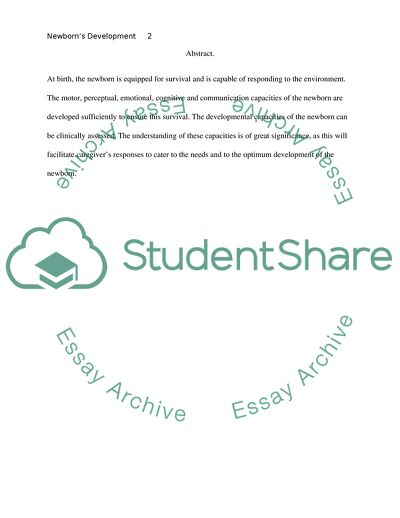
- Home
- Free Samples
- Premium Essays
- Editing Services
- Extra Tools
- Essay Writing Help
- About Us
- Studentshare
- Subjects
- Miscellaneous
- Newborns Development (emotional, cognitive, perceptual, motor and communication capacities)
Newborns Development (emotional, cognitive, perceptual, motor and communication capacities) - Essay Example

- Subject: Miscellaneous
- Type: Essay
- Level: Ph.D.
- Pages: 4 (1000 words)
- Downloads: 0
- Author: streutel
Extract of sample "Newborns Development (emotional, cognitive, perceptual, motor and communication capacities)"
Contrary to popular conception, the newborn is not totally defenseless and incapable of responding to the new environment outside the womb. The newborn comes equipped with several mechanisms for survival and is surprisingly alert and responsive to external stimuli. Development, or changes in growth, is particularly rapid at this stage. The development of newborns includes motor, perceptual, emotional, cognitive and communication capacities and merits study as this will influence the caregiver’s responses and enhance the well-being of the infant.
The motor capacities of the newborn are restricted to reflexes, which are automatic or involuntary responses to particular stimuli. Newborns exhibit the following reflexes: (1) The Moro reflex, or the ‘Startle response’ : When the newborn is startled by loud noise, or sudden movement, the infant flings arms and legs outward, extends the head, cried loudly and draws the arms together. (2) The Babinski reflex: When the sole of the newborn’s foot is stroked on the outside from the heel to the toe, the toes fan out and curl and the foot twists inward. (3) The Palmar grasp reflex: When the newborn’s palms come in contact with an object, the hands close around the object and grasp tightly. (4) The Stepping or Walking reflex: When the newborn is held with the feet flat on a surface, one foot will be lifted after the other in a stepping motion. (5) The Rooting and Sucking reflexes are particularly strong in newborns.
When the newborn’s cheek, or sides of the jaw, is touched, the head turns and searches for the nipple. When any object comes near the mouth, the newborn begins sucking. Reflexes are geared towards the baby’s survival during the labor and delivery and usually disappear in about three months after birth. (Ruffin, 2001). Perception in the newborn includes the sensory activities of sight, hearing, touch, taste and smell, which are used to respond to the environment. (1) Sight. When a newborn is picked up
...Download file to see next pages Read MoreCHECK THESE SAMPLES OF Newborns Development (emotional, cognitive, perceptual, motor and communication capacities)
Newborn stages of development
Physical and Cognitive Development in Infancy
Emotion and cognition
Young Child - Development from Prebirth through Age Eight
Toddlers Physical, Cognitive and Socio-Emotional Development
Physical and Cognitive Development in Infancy
Perpetual-Motor Synergies
Cognitive vs Emotional Intelligence Evaluation

- TERMS & CONDITIONS
- PRIVACY POLICY
- COOKIES POLICY